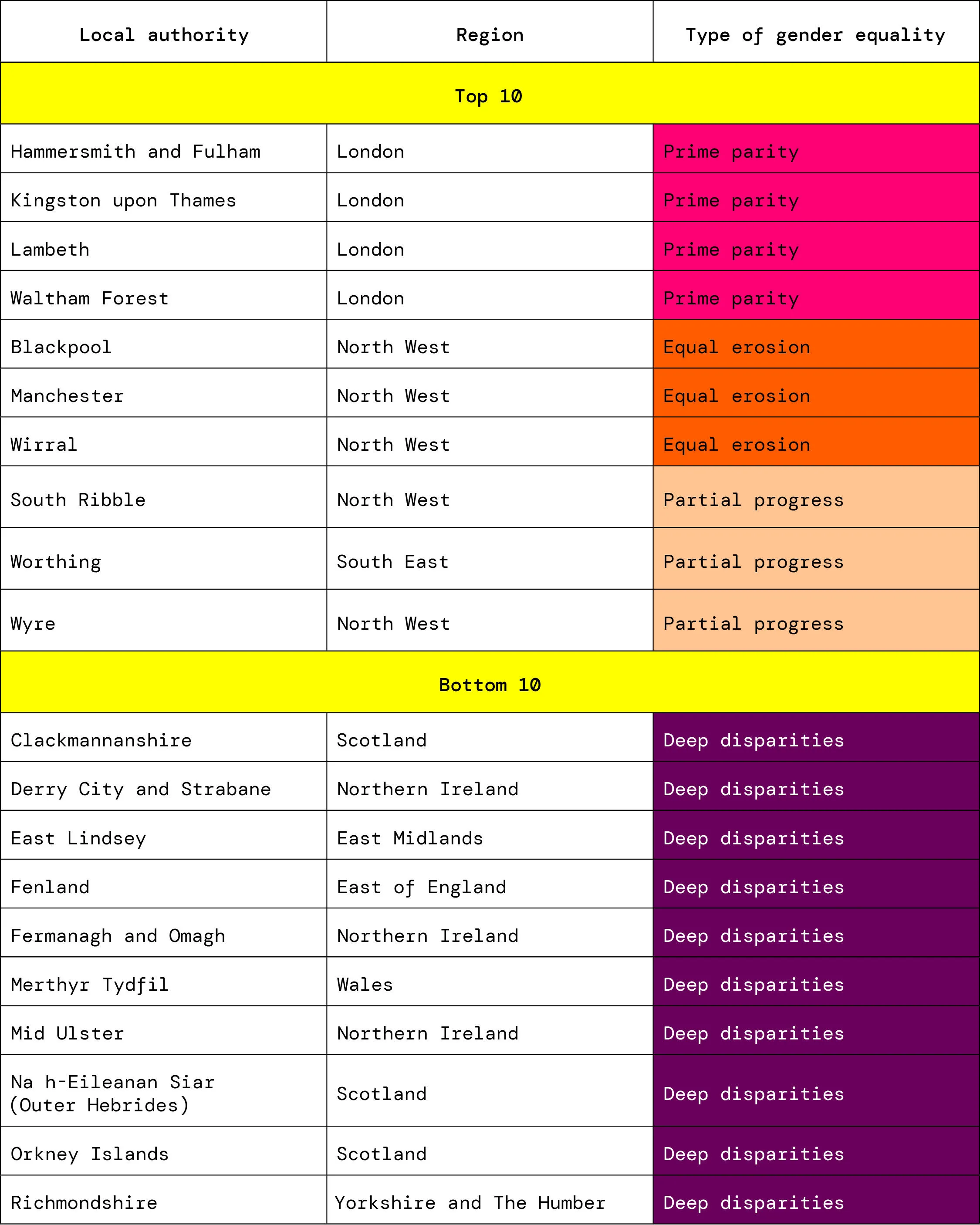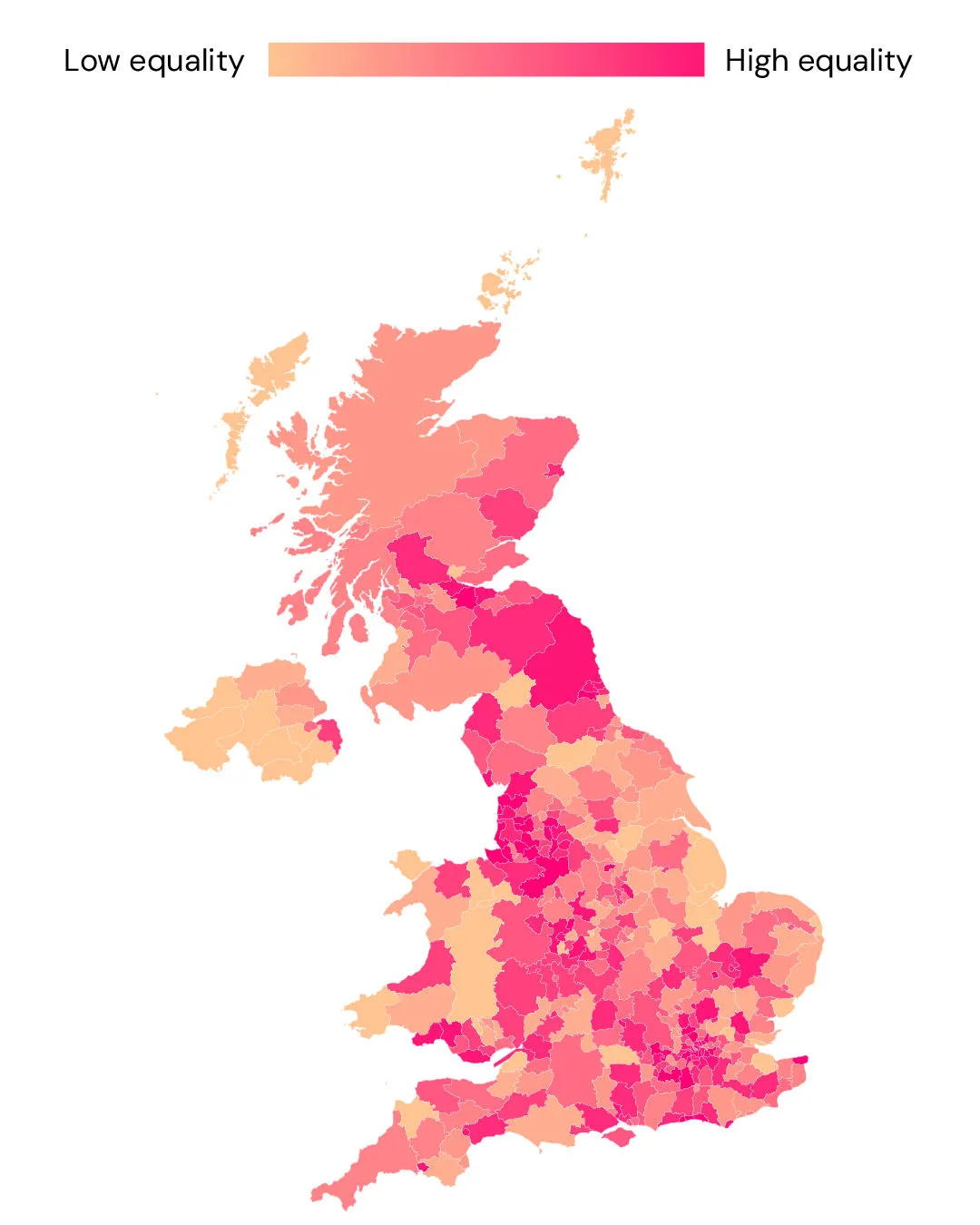Mapping Progress: Launch of the Gender Equality Index UK
Join us for the Gender Equality Index UK launch—the first comprehensive measure of gender equality across 372 local authorities
14 May 2025
The findings show gender equality is not a zero-sum game – it flourishes where women and men both do well

The first comprehensive analysis of gender equality across all 372 UK local authorities1 reveals significant disparities in outcomes for women and men, with none achieving full gender parity.
The Gender Equality Index UK, led by researchers from the Global Institute for Women’s Leadership at King’s College London, provides the most detailed picture to date of how gender and geographic inequalities intersect across the nation.
Drawing on data from 2021-2023, the index measures outcomes across six key domains: paid work, unpaid work, money, power and participation, education, and health.
The index shows the areas that are faring best and worse for gender equality in the UK, with analysis finding a positive association between more gender-equal areas and stronger economic outcomes and growth, suggesting greater equality can benefit everyone, not just women.
The analysis reveals London and the North West dominate the top 10 most gender-equal regions of the UK – though for different reasons.
Areas in the capital, such as Hammersmith and Fulham, Lambeth and Kingston upon Thames, feature high levels of gender equality alongside high outcomes for both women and men, reflecting shared progress.
By contrast, North West areas, like Blackpool, Manchester and the Wirral, appear in the top 10 only because outcomes are equally poor for both genders.
Meanwhile, the bottom 10 for gender equality includes areas across all four nations, including East Lindsey in England, Clackmannanshire in Scotland, Merthyr Tydfil in Wales, and Mid Ulster in Northern Ireland.
Areas such as these, where there is little equality between genders, are also where women’s and men’s outcomes are well below the national average, with many of these bottom-ranking local authorities sharing economic challenges following the decline of their traditional industries, such as manufacturing, agriculture, or fishing.
The patterns exposed by the GEIUK highlight a pressing need for targeted investment to raise gender equality levels while improving the economic and structural conditions in an area, the researchers say.

Overall, the findings confirm a stark North-South divide, with women and men in southern England generally experiencing greater levels of equality and above-average outcomes compared to those in the North of England and Wales. Northern Ireland and Scotland show more mixed patterns.

The research finds a positive association between more gender-equal areas and greater economic activity, higher productivity, better wages, and lower levels of deprivation, suggesting gender equality should not only be pursued as a goal in itself, but as a route to more inclusive growth and regional development.
Despite ongoing debates about “left behind” boys and men, who are often assumed to be losing out due to women’s success and better outcomes, the researchers conclude: “Gender equality is not a zero-sum game: it flourishes where women and men do well.”
The index identifies four distinct patterns of gender equality:
Gender inequalities are particularly pronounced in unpaid work – where women continue to shoulder most childcare and domestic responsibilities – and in power and participation, where women trail behind men in business leadership, political representation and civic engagement.
The research indicates that men’s greater involvement in unpaid care work is associated with better socioeconomic outcomes for men themselves – again suggesting additional benefits to gender equality, although the researchers emphasise this does not establish a causal link.
The report makes a range of recommendations to address gender inequalities in the UK and improve outcomes for women and men across the different domains analysed:
An interactive website – genderequalityindex.uk – allows policymakers, researchers and the public to explore the data used in the Gender Equality Index UK and identify where inequalities are most pronounced and where gains can be made.
Dr Caitlin Schmid, Research Fellow at the King’s Global Institute for Women’s Leadership, said:
“The United Kingdom faces a critical moment marked by economic challenges, regional divides and entrenched inequalities giving rise to increasing discontent. The Gender Equality Index UK brings these issues into sharp focus, exposing how gender and geography intersect to shape the lives of women and men across the country. Confronting these inequalities is fundamental to the government’s mission of improving living standards and creating a more resilient, prosperous and equitable future for all.”
Julia Gillard, former Prime Minister of Australia and Chair of the King’s Global Institute for Women’s Leadership said:
“The findings from this index reveal that while no local authority has yet achieved gender parity, those coming closest often exhibit greater local productivity and higher outcomes for all. This suggests a profound opportunity – not just to close gender gaps, but to promote inclusive regional growth and shared prosperity.”
Professor Heejung Chung, Director of the King’s Global Institute for Women’s Leadership, said:
“Our research highlights the benefits of gender equality for men. For instance, in contexts where men take on a greater share of unpaid care work, they tend to experience better socioeconomic outcomes. This report reaffirms that gender equality is not, and has never been, a zero-sum game. It offers a set of blueprints for how we can develop and support communities in which both men and women can prosper.”
1. Total number of local authorities does not include the City of London and Isles of Scilly due to small population size.
Join us for the Gender Equality Index UK launch—the first comprehensive measure of gender equality across 372 local authorities